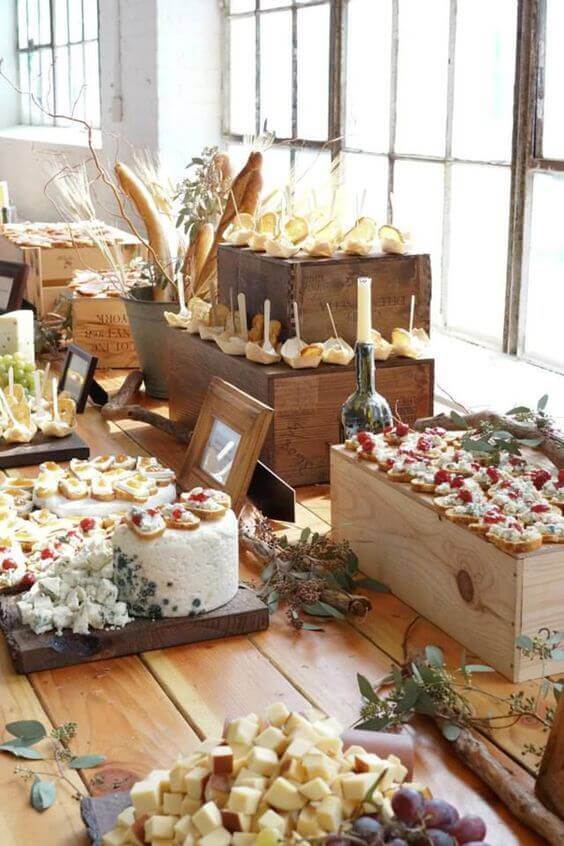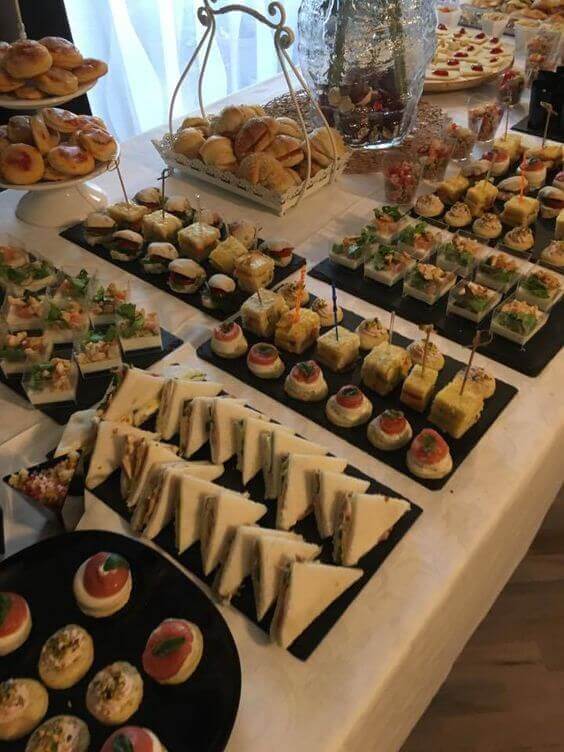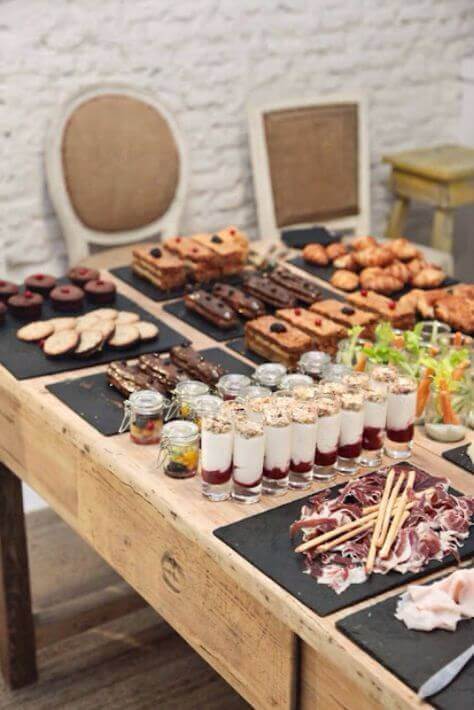Keys to Organizing a Small Buffet At Home

When you’re designing and organizing the presentation of a home buffet, it’s very important to analyze certain aspects. These key elements will determine the level of success you have. You’ll also pleasantly surprise your guests.
It’s crucial to recognize the fact that the presentation of a good home buffet is linked to both aesthetic and technical factors. That is, the decoration of your buffet is just as important as the quality and quantity of the food that you’re going to prepare.
You should also think about what time of year you’re going to organize your feast, the nationality of your guests, and their age, and plan accordingly. Lastly, but no less important, you should also consider the average cost per head you want to spend.
Now, let’s look at a practical formula, or technique, that you can use to organize your next buffet at home. Later, we’ll take a look at how to make good use of color with different foods and serving dishes.
Organizing a home buffet – the FAHB technique

You might ask what is the FAHB technique? We’ll tell you below. The FAHB technique involves developing each of the aspects that each letter stands for in its turn. Here are the keys to success for any forays you make into planning home buffets:
F = Freshness
Any food that you present in a buffet style, whether it’s cold food or at room temperature, should give be fresh and very recently prepared.
Make sure you cut the different foods correctly, and that the resulting portions don’t look dry or misshapen. You should also keep a careful eye on cold or hot sauces, to make sure they don’t form a skin on the surface from sitting there too long.
With any pastries, the texture and color should look appealing. Also, the salads shouldn’t appear as though they’ve been marinating for a week.
And what about desserts? Cakes and other cut items should be cleanly cut and compact, and not look dried out.
A = Abundance

This aspect of abundance should play a crucial role in the presentation of your buffet. You should look for the right size platters and serving bowls according to both the number of guests you’ll be having over, and depending on the amount of food you’re going to serve.
It’s important to avoid any dishes that look half empty. This includes salad bowls, jugs of drinks and sauces, plates with nibbles, etc. This will give the appearance of there not being quite enough food to go around.
You can play around with the display of the whole buffet table as well as the serving dishes to produce a nice full looking effect. Fill up the serving plates and jugs to at least three-quarters full, and you can cover these with cloths until your guests are ready to eat.
It’s even a good idea to make the spaces between the dishes look smaller by scattering leaves, flowers, etc. This is an excellent way to create a sense of abundance in the presentation and servings.
H = Height
Height, when well used in a buffet, carries out the function of breaking up the monotony. It also helps to highlight the different foods that you are presenting. It can give them volume and variety and make them look more appetizing.
In today’s market, you can find an almost infinite range of display items such as boxes and racks to create platters of diverse heights. In this way, you can make use of different bowls, serving platters and dishes set at distinct heights.
Using these aids will help you create a varied look for your buffet, and will help to bring the different foods together harmoniously.
Different heights will also help you to create a visual effect that will help your guests, even those seated at the table, to notice the various foods on display. They’ll be able to look forward to what they’ll choose to eat.
B = Balance
Balance doesn’t just refer to the fact that cold foods should stay cold and hot foods should stay hot. (This, of course, applies as much to using chafing dishes as to hot plates.) It also refers to the harmony that the whole of your buffet display should show.
When organizing your home buffet, make sure that each food that you serve is an appealing and suitable color for the food type. This will add to the harmonious display.
Knowing a little about color psychology is very useful. This will help you when you consider the environment or the feel of the room where you’re organizing your home buffet. Take into account the room’s existing decor and add color and decorations as necessary.
But what about the color of the food you’re serving, as well as the color of the serving dishes? What should you know?
How to use color in foods when organizing your buffet at home

Color plays a vital role in the presentation of food. Many of the failures in food businesses are owed to the fact that the effects produced by certain color contrasts aren’t appealing.
Here’s a handy tip. You should present colorful food items against a neutral background. Consider the relationship between certain color contrasts.
With this in mind, place darker food items on plain or light-colored dishes. Lighter foods should be on platters of intense or dark shades.
Organizing your home buffet – tips for using color in serving dishes
Would you like some examples of the correct use of color in food display and serving platters? Here are some tips on which colors to use with different types of foods:
- The color red goes very well with hot food. You can use platters of clay and copper.
- The color green is an excellent match for cold and fresh areas. Think salads, whole fruit, cut fruit… a good choice for decorating with green plants, fig leaves, etc.
- Blue is ideal for the presentation of cooked seafood, cold platters, fish salads, etc. Since this color is closely associated with the sea, we recommend you spice up the decor a bit if you’re going for a seafood themed buffet. Try using some netting, oars, rudders, anchors, small boats to decorate the table…
- The color yellow is appropriate for identifying areas items such as pastries, bread, and dried fruits and nuts. To create the desired effect you can decorate with grain stalks, small wicker holders, and dried flowers.
- What about the color white? This can be very useful to intensify neutral areas where you put out things such as pates, honey, and jam. To highlight the sensation of cleanliness, use white plates, platters, and bowls.
We hope these few key tips will help you the next time you’re organizing a small buffet at home. We’re sure your guests will be impressed. We’d love to see the results!
When you’re designing and organizing the presentation of a home buffet, it’s very important to analyze certain aspects. These key elements will determine the level of success you have. You’ll also pleasantly surprise your guests.
It’s crucial to recognize the fact that the presentation of a good home buffet is linked to both aesthetic and technical factors. That is, the decoration of your buffet is just as important as the quality and quantity of the food that you’re going to prepare.
You should also think about what time of year you’re going to organize your feast, the nationality of your guests, and their age, and plan accordingly. Lastly, but no less important, you should also consider the average cost per head you want to spend.
Now, let’s look at a practical formula, or technique, that you can use to organize your next buffet at home. Later, we’ll take a look at how to make good use of color with different foods and serving dishes.
Organizing a home buffet – the FAHB technique

You might ask what is the FAHB technique? We’ll tell you below. The FAHB technique involves developing each of the aspects that each letter stands for in its turn. Here are the keys to success for any forays you make into planning home buffets:
F = Freshness
Any food that you present in a buffet style, whether it’s cold food or at room temperature, should give be fresh and very recently prepared.
Make sure you cut the different foods correctly, and that the resulting portions don’t look dry or misshapen. You should also keep a careful eye on cold or hot sauces, to make sure they don’t form a skin on the surface from sitting there too long.
With any pastries, the texture and color should look appealing. Also, the salads shouldn’t appear as though they’ve been marinating for a week.
And what about desserts? Cakes and other cut items should be cleanly cut and compact, and not look dried out.
A = Abundance

This aspect of abundance should play a crucial role in the presentation of your buffet. You should look for the right size platters and serving bowls according to both the number of guests you’ll be having over, and depending on the amount of food you’re going to serve.
It’s important to avoid any dishes that look half empty. This includes salad bowls, jugs of drinks and sauces, plates with nibbles, etc. This will give the appearance of there not being quite enough food to go around.
You can play around with the display of the whole buffet table as well as the serving dishes to produce a nice full looking effect. Fill up the serving plates and jugs to at least three-quarters full, and you can cover these with cloths until your guests are ready to eat.
It’s even a good idea to make the spaces between the dishes look smaller by scattering leaves, flowers, etc. This is an excellent way to create a sense of abundance in the presentation and servings.
H = Height
Height, when well used in a buffet, carries out the function of breaking up the monotony. It also helps to highlight the different foods that you are presenting. It can give them volume and variety and make them look more appetizing.
In today’s market, you can find an almost infinite range of display items such as boxes and racks to create platters of diverse heights. In this way, you can make use of different bowls, serving platters and dishes set at distinct heights.
Using these aids will help you create a varied look for your buffet, and will help to bring the different foods together harmoniously.
Different heights will also help you to create a visual effect that will help your guests, even those seated at the table, to notice the various foods on display. They’ll be able to look forward to what they’ll choose to eat.
B = Balance
Balance doesn’t just refer to the fact that cold foods should stay cold and hot foods should stay hot. (This, of course, applies as much to using chafing dishes as to hot plates.) It also refers to the harmony that the whole of your buffet display should show.
When organizing your home buffet, make sure that each food that you serve is an appealing and suitable color for the food type. This will add to the harmonious display.
Knowing a little about color psychology is very useful. This will help you when you consider the environment or the feel of the room where you’re organizing your home buffet. Take into account the room’s existing decor and add color and decorations as necessary.
But what about the color of the food you’re serving, as well as the color of the serving dishes? What should you know?
How to use color in foods when organizing your buffet at home

Color plays a vital role in the presentation of food. Many of the failures in food businesses are owed to the fact that the effects produced by certain color contrasts aren’t appealing.
Here’s a handy tip. You should present colorful food items against a neutral background. Consider the relationship between certain color contrasts.
With this in mind, place darker food items on plain or light-colored dishes. Lighter foods should be on platters of intense or dark shades.
Organizing your home buffet – tips for using color in serving dishes
Would you like some examples of the correct use of color in food display and serving platters? Here are some tips on which colors to use with different types of foods:
- The color red goes very well with hot food. You can use platters of clay and copper.
- The color green is an excellent match for cold and fresh areas. Think salads, whole fruit, cut fruit… a good choice for decorating with green plants, fig leaves, etc.
- Blue is ideal for the presentation of cooked seafood, cold platters, fish salads, etc. Since this color is closely associated with the sea, we recommend you spice up the decor a bit if you’re going for a seafood themed buffet. Try using some netting, oars, rudders, anchors, small boats to decorate the table…
- The color yellow is appropriate for identifying areas items such as pastries, bread, and dried fruits and nuts. To create the desired effect you can decorate with grain stalks, small wicker holders, and dried flowers.
- What about the color white? This can be very useful to intensify neutral areas where you put out things such as pates, honey, and jam. To highlight the sensation of cleanliness, use white plates, platters, and bowls.
We hope these few key tips will help you the next time you’re organizing a small buffet at home. We’re sure your guests will be impressed. We’d love to see the results!







